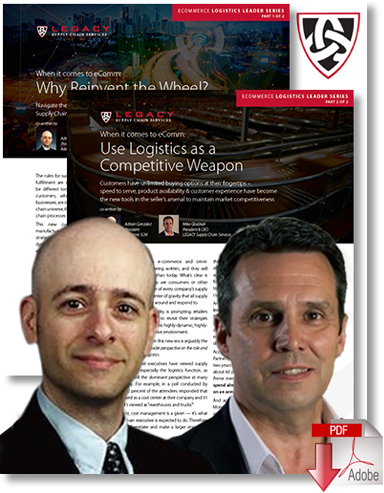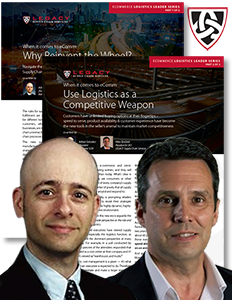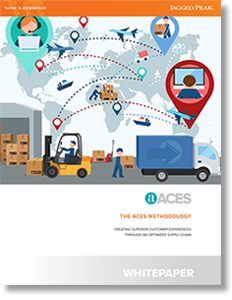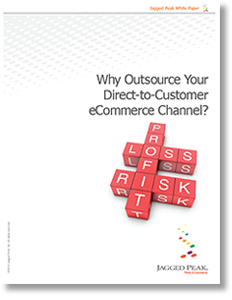Using Your Logistics Expertise as a Competitive Weapon When It Comes To Ecommerce

Customers have unlimited buying options at their fingertips - speed to serve, product availability & customer experience have become the new tools in the seller’s arsenal to maintain market competitiveness.
The rules for success in ecommerce and omnichannel fulfillment are still being written, and they will likely be different tomorrow than today.
What’s clear is that customers, whether they are consumers or other businesses, are now the center of every company’s supply chain universe; they are the center of gravity that all supply chain processes must revolve around and respond to.
This new customer-centric reality is prompting retailers and manufacturers of all sizes to revisit their strategies and capabilities to succeed in this highly-dynamic, highly uncertain, and highly-competitive environment.
The first step toward success in this new era is arguably the most important: taking a broader perspective on the role and value of supply chain and logistics.
For a long time, C-level executives have viewed supply chain management, especially the logistics function, as a cost center. It’s still the dominant perspective at many companies today.
For example, in a poll conducted by SAP last year, 42 percent of the attendees responded that logistics is viewed as a cost center at their company and 31 percent said it’s viewed as “warehouses and trucks.” (Your Supply Chain Strategy is Your Business Plan (Unless It’s Not)).
Today, however, cost management is a given - it’s what every supply chain executive is expected to do. Therefore, how do you differentiate and make a larger impact on the organization? You have to think and act beyond cost management and find ways to leverage supply chain and logistics as a competitive weapon - that is, look for ways to leverage supply chain management to drive top-line growth, increase market share, and enhance customer loyalty.
Amazon is the best example today of a company that is leveraging logistics as a competitive weapon. Its Amazon Prime service, which provides members with free 2-day shipping (among other benefits), and its large and diversified distribution network are not only pushing the envelope on consumer delivery expectations, they are also driving higher sales and market shares for the company.
According to a study by Consumer Intelligence Research Partners, Amazon Prime membership doubled in the last two years to more than 80 million people in the U.S., with about 60 percent of all U.S. Amazon shoppers now being Prime members. CIRP also found that Prime members spend almost twice as much as non-Prime customers on an annual basis - $1,300 versus $700 (Amazon Prime Doubles in Size in Two Years).
And according to data from Slice Intelligence, on the Monday before Christmas last year, 49.2 percent of all online sales in the United States were made on Amazon, with consumers doing their shopping later, “secure in the knowledge that Amazon’s two-day delivery would still get them what they’d ordered before it was too late.” (Amazon grabbed half of last-minute, online Christmas shoppers).
Intel is another example of a company that is leveraging its supply chain and logistics capabilities and expertise to drive top-line growth, increase market share, and enhance customer loyalty.
At the Council of Supply Chain Management Professionals (CSCMP) Annual Conference last year, Ninette Vaz and Greg Skrovan from Intel shared the success the company has achieved to date with its SC@Intel program, where volunteers from its supply chain organization, working collaboratively with the sales team, provide insights and advice to existing and prospective customers to help them with their supply chain challenges and objectives.
These subject matter experts (SMEs) also work with Intel’s product teams to see if some of the company’s existing products and technologies can be used to improve supply chain and logistics operations.
According to Skrovan, in the first year of the program, supply chain SMEs have participated in 50 customer engagements, including six deals accounting for $30 million in new revenue (At Intel, supply chain makes sure it's “in the room where it happens”).
They also launched 7 proof-of-concepts, including using Intel RealSense technology in warehouses to quickly calculate the dimensional weight for shipping and improve load planning (Intel IoT Unlocks True Value in Connected Supply Chains).
Amazon and Intel provide clear evidence of the benefits companies can achieve if they take a broader perspective of supply chain and logistics. However, transforming from a “logistics is a cost center” mentality to a mindset of “logistics is a competitive weapon” is not a quick and easy process.
How Do You Get Started? Here Are Four Recommendations:
1. Focus on Customers: Understand Their True Requirements and Expectations. In his most recent letter to shareholders, Amazon CEO Jeff Bezos writes, “There are many ways to center a business. You can be competitor focused, you can be product focused, you can be technology focused, you can be business model focused, and there are more. But in my view, obsessive customer focus is by far the most protective of Day 1 vitality” (“Jeff, what does Day 2 look like?”).
Define your metrics and measures of success through a customer’s point of view, not yours. An order shipped on time, for example, is not the same as an order delivered on time.
Also, don’t make assumptions about what your customers want and expect; have thorough conversations with them to uncover their true requirements. Through these conversations, service requirements and customer expectations become aligned - with limitless potential outcomes.
For example, understanding the difference between a requirement to always ship airfreight vs. a requirement to receive orders within 24-hours could present opportunities to replace costly airfreight shipments with an expedited truck (at one fifth the cost).
Or, understanding customer demand patterns at a deeper level could create opportunities to conduct online order fulfillment activities within an already-existing warehouse or distribution center.
Finally, to quote Bezos again, “Even when they don’t yet know it, customers want something better, and your desire to delight customers will drive you to invent on their behalf. No customer ever asked Amazon to create the Prime membership program, but it sure turns out they wanted it.”
2. Link the Value of Supply Chain and Logistics to the Company’s Strategy and Business Plan. While a growing number of companies are appointing supply chain executives as CEOs - such as Tim Cook at Apple, Mary Barra at GM, Fabian Garcia at Revlon, John Hendrickson at Perrigo, Bali Padda at Lego, and most recently, Jesper Brodin at IKEA - the fact is that many C-level executives have a very limited understanding of supply chain and logistics, and they fail to recognize the broader benefits it can provide if leveraged effectively.
All they know, in many cases, is that goods arrive and depart from a dock at the back of the building, preferably on time and as cheaply as possible.
Therefore, having a knowledgeable and experienced executive in the C-Suite who can link the value and role of supply chain management to the company’s strategy and business plan is critically important.
Unfortunately, research shows that only 24 percent of manufacturers have a Chief Supply Chain Officer (CSCO), which aligns with the afore-mentioned SAP poll where only 14 percent of the respondents reported having a CSCO, with another 11 percent responding “I wish!” (Majority of Manufacturers Do Not Have Chief Supply Chain Officer).
Achieving profitable growth is such an important strategic objective for so many companies. The rapid expansion of e-comm has created an opportunity for businesses to strategically align their supply chain upstream with suppliers and downstream with sales, marketing & customer service. Companies like Amazon and Intel have strategically leveraged their supply chain functions in very different ways to drive sustainable, top-line business growth.
Alignment can also happen at a more grassroots level - it’s important for people on the frontlines of supply chain and logistics to understand their role and overall impact on the company’s success. In many cases, employees in the supply chain function are rarely provided with an organization-wide view of how their contributions help drive top-line growth, in addition to bottom line cost savings.
From their perspective, their job is simply to pick, pack, ship & manage inventory. Providing everyone in the supply chain and logistics organization with visibility into how their role matters in the big picture have a positive bottom-up effect on delivering value to customers, and ultimately to achieving profitable business growth.
3. Promote Enhanced Collaboration Between Supply Chain, Logistics, Sales, Marketing, and Customer Service. The SC@Intel program is a great example of how enhanced collaboration between the Supply Chain and Sales teams can lead to increased revenues and enhanced customer satisfaction.
Another recent example: a supply chain executive at a leading food manufacturer was working closely with the sales team to educate them on how to position the company’s supply chain and logistics capabilities as a competitive differentiator with their clients & prospects.
To paraphrase his message to the sales team: “Our ability to respond quickly and effectively to fluctuations in demand, adjust order sizes and delivery frequency as required, and provide timely and accurate visibility to orders, inventory, and other metrics are all competitive weapons - let’s use them to our advantage!”
Simply put, break down the silos between these teams and work together toward achieving a shared mission statement focused on delighting your customers, which in turn will lead to increased revenues and market share.
4. Leverage the Knowledge, Expertise, and Resources of Your 3PL partners. Relatively few companies have the internal resources and capabilities to transform their supply chains alone, which is why they rely on third-party logistics partners to assist them on the journey.
According to the 2017 Third Party Logistics Study, 73% of the shipper respondents indicated the meaningful involvement of 3PLs in processes relating to supply chain transformation. Within that- 9% suggested their 3PL had very significant involvement, 28% significant involvement, and 36% acted in an advisory role (Download The 21st Annual, 2017 Third-Party Logistics Study). “Users and providers agreed that 3PLs could be of assistance with their 3PL industry knowledge, supply chain experience, and shipper industry knowledge,” states the report.
As you begin your journey toward making logistics a competitive weapon, collaborate with your current third-party warehouse and logistics partners because they already possess two critical attributes for success: they have already earned your trust by successfully managing your existing fulfillment operations and they are already very knowledgeable about your products and supply chain, as well as very knowledgeable about emerging trends and leading practices in the industry.
Note: This is part 2 of 2 of an Ecommerce Logistics Leader Series, read part 1 Navigating Ecommerce with Your Existing Supply Chain Relationships & Capabilities
Related Resources
Ecommerce Logistics Leader Series New!
Co-written by Adrian Gonzalez and Mike Glodziak, this ecommerce logistics leader series describes how you can get to market faster, by leveraging your existing network, resources, and relationships to their fullest potential as well as how you can use logistics as a competitive weapon. Download Now!
International Transportation: Price Matters, But At What Cost?
This ebook is a comprehensive guide to international transportation, that will help logistics managers better evaluate and plan their; supply chain strategy, logistics infrastructure, and risk mitigation strategy. Download Now!
Keeping Up with the Retail Consumer
6 supply chain disciplines retailers must master - developed by Adrian Gonzalez, founder and president of Adelante SCM and LEGACY Supply Chain Services, with a foreword from Rick Blasgen, president and CEO, CSCMP. Download Now!
Rapidly Improve the Performance of Your Warehouse
The Rapid Performance Evaluation identifies opportunities and potential improvements in every aspect of warehouse operations; performance, productivity, service, quality, and systems. Download Now!
Creating Superior Customer Experiences through an Optimized Supply Chain
This paper describes in detail the Jagged Peak ACES model and how it can be used as a methodology for measuring each element of the order lifecycle and its impact on customer experience. Download Now!
Why Outsource Your Direct-to-Customer eCommerce Channel?
To better focus on their core competencies, more and more manufacturers recognize that outsourcing is an effective and economical way to manage their direct-to-customer (D2C) eCommerce channel. Download Now!
More LEGACY Supply Chain Services Resources
Article Topics
LEGACY Supply Chain Services News & Resources
Outsourcing eCommerce Fulfillment to a 3PL Rapidly Improve the Performance of Your Warehouse Logistics 20 Warehouse & Distribution Center Best Practices for Your Supply Chain Warehouse Contingency Planning Template 7 Last Mile Logistics Delivery & Ecommerce Trends You Don’t Want to Overlook Increase Inventory Visibility across Your Supply Chain and Optimize Omni-Channel Fulfillment Omni-Channel Logistics Leaders: Top 5 Inventory Insights More LEGACY Supply Chain ServicesLatest in Supply Chain
Ranking the Best Countries for Private Business in EMEA Frictionless Videocast: The Importance of Water at the U.S./Mexico Border with Commissioner Maria-Elena Giner, International Boundary and Water Commission Why are Diesel Prices Climbing Back Over $4 a Gallon? Walmart Unleashes Autonomous Lift Trucks at Four High-Tech DCs Plastic Pollution is a Problem Many Companies are Still Ignoring Luxury Car Brands in Limbo After Chinese Company Violates Labor Laws 80% of Companies Still Unsure How to Best Leverage AI, Study Finds More Supply Chain





















